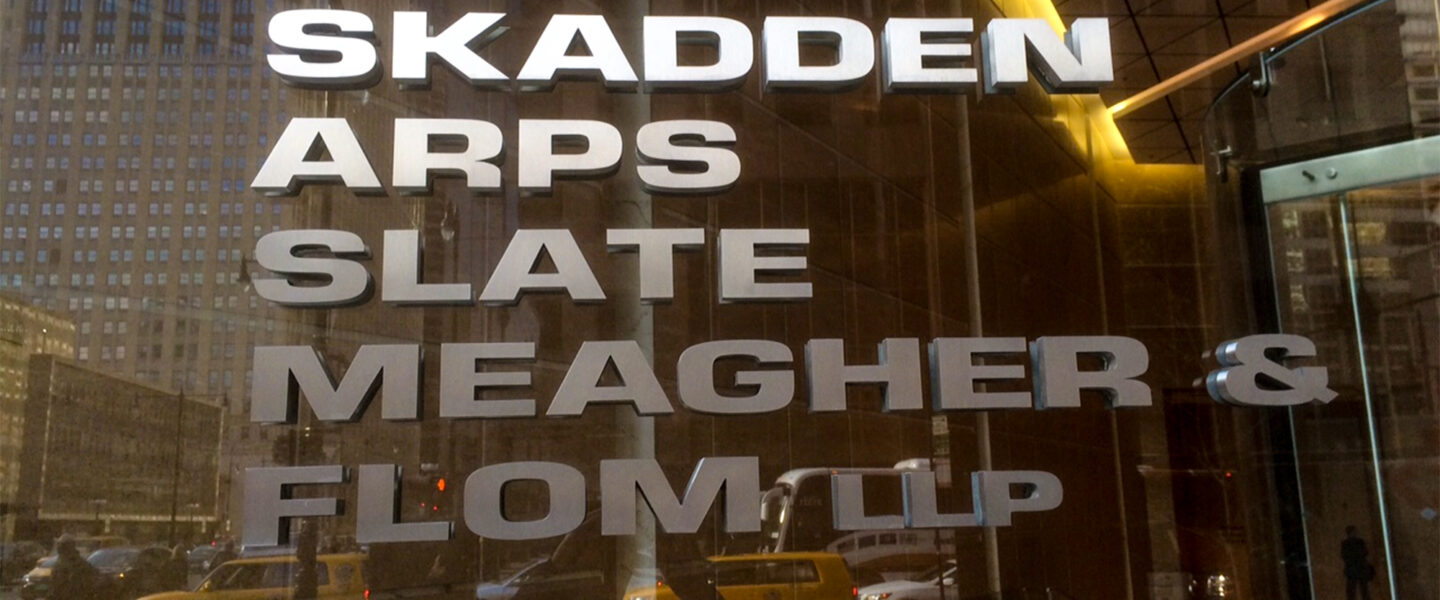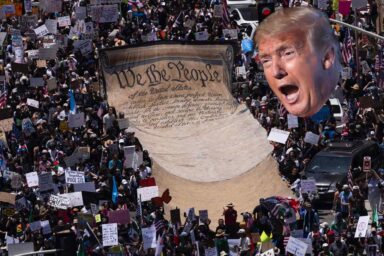It was always about making money, but once upon a time, when I worked at Skadden, I thought I detected a soul.
|
Listen To This Story
|
About this time of year, 44 years ago, I found myself at the Skadden law firm, then on midtown Manhattan’s East Side, interviewing for a job as a summer associate — a hire that promised to lead, in the normal course of events, to a permanent position at the firm.
An honors student at NYU School of Law, I had already interviewed successfully at several other big firms, all of them — including Paul Weiss — more venerable and “white shoe” than Skadden.
Skadden, Arps, Slate, Meagher & Flom had made its name (and money) in what was then the new, and exploding, legal sport of “mergers and acquisitions” (M&A, for short). I think it’s fair to say that, while not all mergers and acquisitions are terrible, the collective impact tends to be monopolistic, bad for workers and consumers, and great for corporate moguls, manipulators, banks, and big investors — think real-life Carl Icahn, Hollywood’s Gordon Gekko — and of course quite profitable for the law firms that serve them.
So Skadden wasn’t exactly the kind of place that was attractive to a public interest-minded, business-skeptical, and Reagan-despising law student such as myself.
I applied as something of a lark, channeling my bitterness at the damage Ronald Reagan and a rightward-veering SCOTUS had already done into a bemused, ironic, and somewhat flippant visit to a place I was sure I’d turn down.
My indifference, bordering on contempt, gave me an extra measure of courage, and I decided that — unlike in my other interviews, where I had more or less been a good boy and delivered the requisite forkloads of fertilizer — I’d just let my pants down and tell my interviewers the truth.
The truth was that I had little or no intention of joining any big firm, let alone 80-hours-per-week Skadden. I saw myself, at that moment, as a future low-pay public interest lawyer, perhaps one day a professor, fighting against things like the death penalty and for things like gun control and public financing of election campaigns — futile as such causes were beginning to seem, a year into the Reagan “revolution.”
The truth was I saw big firms like Skadden — and Skadden more than most — as parasites, selling their souls so that corporations and individuals with gobs of money could make still more of it; saw them as well-paid penny boys lubricating the gears of high finance and corporate dominance.
The truth was I had already glimpsed enough of the yawning gulf between “law” and “justice” — and perceived, as well, the tight correlation between wealth and legal outcomes — to seriously doubt whether I could stomach a life in the legal profession.
The truth was, if I was interested in working there at all, it was to confirm my strong suspicion that it was the devil’s den and the last place I’d want to spend my working life.
I told them all this — not a whole lot more tactfully, while struggling to keep eye contact — and added that if by some fluke I did wind up spending my summer at Skadden, it would be with the understanding that I would be assigned pro bono work and not sitting up all night proofing Section 16-b filings on some corporate takeover deal.
To my lasting astonishment, Skadden took a flyer on me. They apparently were not afraid of or repulsed by my “truths,” and didn’t shy away from welcoming a skeptic and critic into their midst. That impressed me — so I, in return, took a flyer on Skadden.
A Tailored Suit
I spent a good part of my summer strutting around in a tailored suit, pumping iron at the New York Athletic Club, and cashing biweekly paychecks for what seemed an obscene amount of money, while researching and writing the appellate brief for a pro bono case in which we successfully defended a non-profit community organization facing a nuisance suit from a litigious crackpot. Skadden, I decided, wasn’t all that bad.
I guess the feeling was mutual, as they extended an offer to me to join them as an associate upon graduation.
I’ll never forget, though, the partner assigned to talk up my future with the firm. Over mixed nuts and beverages in the Plaza Hotel’s Oak Room, he went on and on about deals and perks and the partnership track — he’d obviously not done his homework!
Skadden’s offer was for more money — to start — than I was to wind up making in all but one year of my working life since, in actual dollars not adjusted for inflation.
And it was an offer they kept open for nine years as I wandered around “finding myself,” only to wind up in an entirely different career. They even told me I could work half-time (which I knew meant about 40 hours a week!) to accommodate my other interests and pursuits.
This all touched me deeply. I also came to admire the ethics and the breadth of interests of some of Skadden’s top partners — Roger Aaron, Fin Fogg, and Jim Freund were especially notable in this regard — and found that the ethos was considerably more humanist (and humane) than rumor had it.
And there seemed to be a strong public-spiritedness accompanying the more mercenary pursuits that kept the whole enterprise afloat and expanding — a spirit reflected in one of the stronger pro bono practices of any firm, large or small. I was proud to have been a part of that, if only for a summer.
Do the Fundamental Things Still Apply?
That was then. It’s been a long time. Very few of those who set that tone remain with the firm, or indeed are alive.
I did a little research and found that Skadden today employs more than 1,700 attorneys in 21 offices in over 50 discrete disciplines. It is, as law firms go, huge, powerful, established. But I wonder whether the ethos today bears any resemblance to what I found there 44 years ago.
What I do know is that Donald Trump put Skadden on his growing “list” of big law firms — including the aforementioned Paul Weiss; Covington and Burling; WilmerHale; Jenner & Block; Perkins Coie; Wilkie Farr; and Milbank — hit or threatened with crippling executive orders in undisguised retaliation for their perceived politics and/or their willingness to employ or represent anyone Trump sees as an enemy.
Do some work for former special counsel Jack Smith? Welcome to the List! Hire Kamala Harris’s husband, Doug Emhoff? You too! You think you can get away with putting that bastard Robert Mueller on your payroll? Think again!
The overall aim of Trump’s attacks on these big firms — apart from his insatiable thirst for revenge — is to strike yet another blow against the constraining rule of law itself. The victims — weak and strong — of Trump’s wide-ranging power plays, illegal and/or unconstitutional aggressions and depravities, will have less or no access to legal representation (paid or pro bono) for their cases and causes.
There is no denying the power of the weapon Trump has deployed. Executive orders like the one he signed against Paul Weiss — effectively locking the doors of the federal government and all its agencies to a given firm, even blocking the firm from access to federally generated data and information — pack a devastating punch, threatening to decimate businesses and practices that the firms had spent decades, or in some cases more than a century, building.
No Law Without Lawyers
And of course the overall aim of Trump’s attacks on these big firms — apart from his insatiable thirst for revenge — is to strike yet another blow against the constraining rule of law itself.
The victims — weak and strong — of Trump’s wide-ranging power plays, illegal and/or unconstitutional aggressions and depravities, will have less or no access to legal representation, paid or pro bono, for their cases and causes.
Many judges have been doing what’s in their power to protect democracy by impeding Trump’s swaggering, power-drunk cakewalk — but judges can’t rule without cases, which means they can’t act without skilled, dedicated, and experienced lawyers bringing those cases. And just to be clear, big law firms get big by exuding those qualities, by being good at what they do — being meticulous, getting things right, offering sound counsel, and winning cases.
So Trump — who has already shown a willingness, indeed an eagerness, to defy the courts — is finding yet another way to get his way, by projecting his power against the firms without whose work there might well be fewer, or no, court rulings to defy.
That Trump was dropping nukes, not lobbing mere grenades, was hardly lost on the principals of Paul Weiss and several of the other targeted firms. They sought to save themselves by making deals with Trump that included promises to never cross him, and offers to sweeten the pot with pledges of up to $100 million in pro bono work for causes of Trump’s choosing.
The master extortionist, pleased as punch with this quaking response to his play, couldn’t help gloating last month (have a bucket handy; soundproof your room):
They’re all bending and saying: “Sir, thank you very much.” Nobody can believe it. Law firms are just saying: “Where do I sign? Where do I sign?”
Of course, that is yet another lie to add to Trump’s record count: They are not all bending. A few — Perkins, WilmerHale, and Jenner — have sued Trump, challenging his executive orders against them in federal court.
And over 500 small and midsize firms have thus far filed or signed onto amicus briefs in support of Perkins’s suit, along with several hundred law professors, several hundred former judges, and advocacy groups arrayed along the ideological spectrum. Congress — or at least a few of its members — is now looking into the matter.
But among the behemoths, often referred to as Big Law, the rest have caved or are still trying to find some way out. Much like the academic institutions, industries, and foreign countries Trump has been whacking and threatening — his power lust fed by every concession, every new bow and scrape. The Art of the Kneel!
Obeying, and Paying, in Advance
In the case of Skadden, the mere threat of an executive order was enough to bring the proud firm to its knees in advance — $100 million of their work pledged “pro bono Trumpo” to causes (and criminals?) designated by Trump — maybe the coal industry fighting what’s left, if anything, of environmental regulation; or ICE agents committing war crimes; or some exposed corporation or mogul suing a muckraking journalist for defamation; or perhaps the Proud Boys or some crypto-fraudster golfing buddy.
Maybe the cynical, skeptical view of Big Law I held 44 years ago actually did capture the black — or at least gray — heart beating in its chest. I am sorry for Skadden, sorry that it is not what it was, or what I hoped it might be, all those years ago.
Neither Skadden nor any of the nation’s top 20 firms, even those so far not targeted, has dared to sign on to the brief in support of Perkins, or in any way come to the aid of their targeted cohorts.
In fact, as the head of Paul Weiss noted in a leaked internal email, far from banding together in response to Trump’s offensive, other big firms were quick to try to poach the stricken firm’s clients and employees. Now these firms, including Skadden, are busy trying to put out the internal fires — protests, resignations, potential recruitment woes — that their bowings to Trump have ignited.
This is all so cowardly as to be obscene. Or maybe it’s just business. With survival — or a massive cut in revenue — at stake, maybe you gotta do what you gotta do.
And maybe the cynical, skeptical view of Big Law I held 44 years ago actually did capture the black — or at least gray — heart beating in its chest. I am sorry for Skadden, sorry that it is not what it was, or what I hoped it might be, all those years ago.
But one thing is for certain: If I had a position at, or an offer from, Skadden now, I’d give them one week to rescind their pledge to the extortionist mob boss, or I’d be gone. Of course, given the firm’s apparent evolution as time has gone by, it’s just about as certain that Skadden, as it now exists, would want nothing to do with me.




